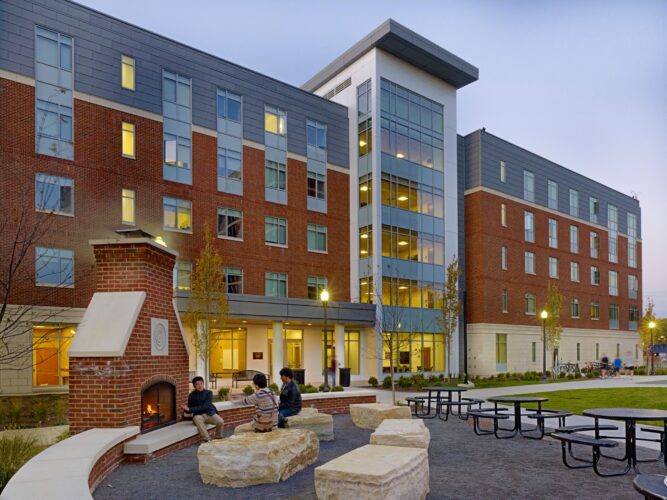Construction
LEED Guidelines
Leadership Energy and Environmental Design standards are considered for developing high-performance, sustainable buildings.New building design incorporate the LEED standards of minimizing light pollution at night, controlling storm runoff, using renewable materials, and improving air quality. The University of Rochester aspires to design and construct each new building to be eligible to achieve LEED Silver certification. Three buildings are officially certified, O’Brien Hall and the Saunder Research Building achieved LEED Gold Certification and Genesee Hall achieved LEED Silver Certification.
Development Density and Community Connectivity
Bulidings are located on a previously developed site and are within ½ mile of neighborhoods and basic services. This encourages a sense of community an channels development to urban areas with existing infrastructure, protects greenfields, and preserves habitat and natural resources.
Heat Island Effect
Buildings minimize impacts on microclimates, and human and wildlife habitats by reducing “Heat island” effect. White roofs, with high reflectivity and emissivity, and vegetative roofs help to cool buildings and the surrounding area.
Controllability of Systems
Light and temperature levels are adjustable in order to provide a high level of lighting control by individual occupants, or groups in multi-occupant spaces. This promotes occupant productivity, comfort, and well-being.
Low Emitting Materials
To improve air quality, low VOC (volatile organic compounds) materials are used in adhesives, paints, and sealants installed in the building.
Regional Materials
Building materials and products used in construction are often manufactured within 500 miles of the site. This reduces the amount of energy required to transport the materials and products to the job site.
Construction Waste Management
Non-hazardous demolition and construction material debris are diverted from disposal landfills and incinerators. Recyclable and recovered debris are reduced back into the manufacturing process.
Recycled Content
Building materials and products are often from recycled sources including: carpet, ceiling tiles and grids, and gypsum drywall paper. This reduces impacts resulting from the extraction and processing of virgin materials.
Water Use Reduction
Low-flow sinks and showers installed in the building are being used to reduce the amount of water used by as much as 45%. This helps to increase water efficiency and reduces the burden on municipal water supply and wastewater systems. The buildings surroundings are inhabited with native vegetation that thrive with no irrigation.
Daylight and Views – Views
The use of large windows allows the occupants to maintain a connection to the surrounding environment and reduces the need for electrical lighting. This results in decreased energy use and contributes to the well-being of occupants.

